Tuesday, August 31, 2010
Tools That Make Twitter More Effective for Your Business/Career
Feds Lower Travel Reimbursements
Traveling feds to get lower reimbursements

The federal government will shell out less money to employees traveling to Washington and most metropolitan areas on official business starting in October, according to new figures.
The General Services Administration, which handles most purchases for government agencies, sets the standard daily travel reimbursement rate at $123 -- $77 for lodging and $46 for meals and incidentals. But about 400 "Non-Standard Areas" -- mostly major metropolitan cities and counties -- have higher rates based on a formula generated by GSA in consultation with the lodging industry that accounts for rental rates, time of year and property value.
Depending on the time of year, daily reimbursement rates for travel to Washington plus meals and other incidentals will drop between $18 and $36 per day starting in October with the new fiscal year, according to GSA (Review the Excel document). The lower rates appear to reflect weakened hotel prices due to the slumping economy.
Federal employees who travel for work keep close tabs on the varying reimbursement rates and often complain that they're forced to subsidize official travel out of pocket because the rates don't always cover all expenses. Washington's lodging industry also track the rate since it effectively sets a number above which a hotel would price itself out of business from traveling feds.
For example, hotel reimbursement rates in Washington this month are $170 and $229 next month, plus $71 a day for meals and incidentals. But in fiscal 2011 the room reimbursement rate will drop to $157 in August and $211 in September (the meal rate will stay the same).
By comparison, feds traveling to New York City can expect combined hotel and meal reimbursements between $262 and $340, a drop during most months. Feds headed to Las Vegas -- a popular convention destination -- will receive $164 in reimbursements -- about a $20 decline. And federal officials visiting New Orleans -- a popular destination for hurricane and BP oil spill-related issues -- can expect reimbursements between $169 and $202, a slight drop from this year.
Monday, August 30, 2010
Stir Fry Ginger Beef
The trick to a good stir-fry is working with a very hot, relatively stick-free pan. I say relatively stick-free because you don't want one of those stick-free pans with the coating that peels off, but say more like a well-seasoned wok or a cast iron frying pan. Hard anodized aluminum will work too, as its surface is bonded into the pan and can take high temperature cooking. Cooking on high heat allows you to get a good sear on the meat and vegetables without overcooking them.
What can I say about this recipe? Not much other than I really like it. The beef strips marinate in a soy, vinegar, honey, ginger marinade, and then fry up quickly with garlic, chile, and more ginger. Top with cilantro and serve over rice. Quick, easy, good.
Stir Fry Ginger Beef Recipe
INGREDIENTS
Marinade
- 2 Tbsp unseasoned rice vinegar
- 5 Tbsp soy sauce
- 1 Tbsp honey
- 1 Tbsp peeled, grated fresh ginger
- 1 teaspoon chile pepper flakes
- 1 teaspoon ground cumin
Beef and stir-fry
- 1 1 1/4 to 1 1/2 lb top sirloin steak
- 1 Tbsp corn starch
- 2 Tbsp vegetable oil (preferably peanut)
- 1 Tbsp sesame oil (optional)
- 3-4 green onions, cut on a diagonal, 1/2-inch apart, including the greens
- 2 cloves garlic, thinly sliced
- 2-3 hot chiles, preferably red serranos, sliced
- 1-inch nob of ginger, peeled, cut lengthwise into matchstick shapes
- 1/2 cup loosely packed, chopped cilantro
METHOD


1 Chill the steak in the freezer for 30 minutes before you slice it, this will make it easier to cut in thin slices. Slice the steak first crosswise in 1/2-inch thick slices. The cut each slice lengthwise into strips.
2 In a medium bowl, whisk together the marinade ingredients; the soy sauce, vinegar, grated ginger, honey, red chile flakes, and cumin. Mix the beef in with the marinade to coat and let it sit for at least 30 minutes, and up to 4 hours, in the fridge.
3 In a small bowl, mix the corn starch with 2 tablespoons of cold water to make a slurry.
4 Heat the oil in a wok, or a large sauté pan, over high heat until it is nearly smoking. As the oil is heating up, pat the beef dry and separate it into small batches no larger than what can fit into the palm of your hand. Working in batches, sauté beef until just brown outside but rare inside, no more than 1 minute. Transfer beef to a bowl.




5 When all of the beef is cooked, put the chiles and garlic into the pan and stir-fry 30-45 seconds. Add the julienned ginger and cook for 30-45 seconds more. Add the beef back to the pan. Add the cornstarch slurry. Add the scallions and mix everything together. Cook for 1 minute.
Turn the heat off and mix in the cilantro. Serve at once with steamed white rice.
Serves 4-6.
Posted via email from WellCare
The Perfect PC: Don’t Buy It, Build It!!
Whether you’ve budgeted $500 for a new machine or given yourself $1200 to spend, our editors show you how to create the best system for the money.
Nate Ralph

The perfect PC means different things to different people. If you search hard enough, you may find a factory-made ma chine that matches your ideal, at a reasonable price. But if you'd rather not wait for a major retailer to hit all the right notes, consider building your own system.
Don't worry--putting together a PC is a lot easier than you might think. And there are plenty of good reasons to do it.
If you've ever had to ship your computer back to the manufacturer for a checkup, the experience may have encouraged you to think seriously about rolling up your sleeves and doing your own troubleshooting. Lengthy turnaround times, or hours spent sitting on hold with customer service are maddening enough. But if your machine happens to be out of warranty--or didn't have a very good warranty to begin with--the cost of getting a part or the entire system replaced could be more than you bargained for.
Most of all, building your own system is fun. Technology has be come increasingly complex, but PCs are modular--and with our step-by-step guide you can put together a dream machine that's just right for your needs and budget.
Note: The do-it-yourself process is a double-edged sword. Whether you've had positive customer service experiences in the past or not, having a single seller to turn to if your equipment goes haywire can simplify troubleshooting (and replacing parts). Getting a faulty component replaced on a home-built machine entails working with individual product manufacturers, which may increase the overall hassle.
But to help those who've never built a PC before, or just need to brush up on their technique, we've created a three-part video series that walks you through the process.
How to Build Your Own PC, Part 1
How to Build Your Own PC, Part 2
How to Build Your Own PC, Part 3
Caveats aside, you'll be hard pressed to find a computer that suits your needs better than one you build yourself. The first and most important step in building a PC is to know exactly what you want it to do. The only thing worse than wasting time assembling a subpar system is spending far more money than you need to, cobbling together a quad-core behemoth that you'll be using just to check your e-mail.
Once you have identified the functions that you want your PC to perform, decide how much you're willing to spend.
A system designed for gaming or video editing will require a larger investment than one intended for nothing more demanding than surfing the Web. Our parts lists enumerate the components that we chose, and explain our rationale--beyond sticking to our budget--for choosing each part.
Testing
For our tests of our DIY system, we used the PCWorld Labs' WorldBench 6 benchmark suite. WorldBench 6 gauges real-world system performance on a series of tests based on common applications. We calculate WorldBench 6 scores by timing how long a machine takes to complete the various tasks, and weighing those numbers against the performance of a baseline system. We also conducted a gaming test, using Unreal Tournament 3 to provide us with a graphical performance benchmark.
With test results in hand, we compared the data for the PC that we built from scratch against the average for machines at similar price levels. All of the competitors we considered were re cently reviewed machines, available at retail.
Our PC vs. the Competition at $500
On a $500 budget, PC manufacturers have a clear advantage: By ordering in bulk and maintaining direct control over their supply chain, they can buy components at lower prices than can an individual user shopping for parts online. On the other hand, they have to pay for assembly (do-it-yourselfers work for free) and of course they have to build in a profit margin.
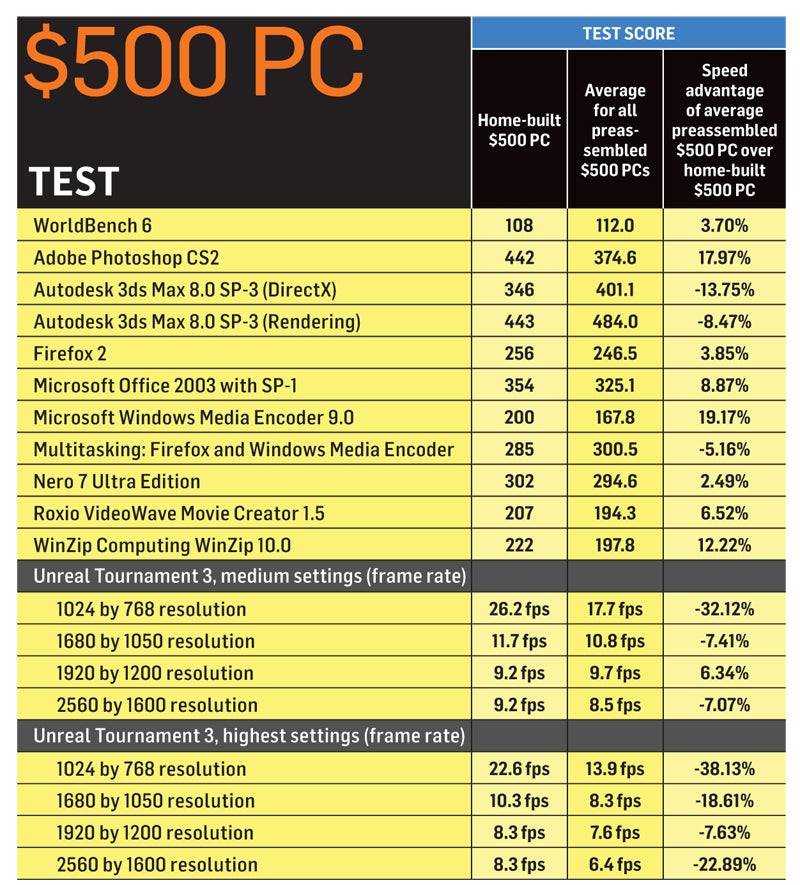
Overall, our results weren't bad. On our WorldBench 6 tests, our $500 system scored 3.7 percent below the average mark for budget desktop PCs in the same price category.
Graphics performance was better--though not exceptionally so. We couldn't eke out a playable frame rate, regardless of setting, which is normal with integrated graphics. Despite such results, our $500 PC still outperformed the category average in gaming frame rates by a considerable amount.
Limitations in gaming performance aside, our $500 ma chine does excel at tackling high-definition content. Our motherboard's integrated graphics chip offers MPEG-2 and H.264 decoding, which helps lighten the load on the CPU. The end result is smooth, stutter-free playback, even at higher resolutions. You'll also have enough power to run multiple displays--an arrangement that's handy for getting work done when you aren't watching your favorite flicks.
Despite its marginally lower performance, our $500 ma chine has a few advantages over competing prefab systems. Machines in the budget desktop PC category generally get tucked into petite, custom cases that don't offer much room to grow. Our Rosewill chassis isn't much larger than the average, but it can accommodate various components that you may want to introduce later on. Likewise, our motherboard's integrated graphics system leaves PCI slots available for adding a discrete graphics card, if we'd eventually like to make our rig a bit friendlier for gaming or video editing.
Our PC vs. the Competition at $1200
Though our $500 machine struggled a bit to keep up with its low-cost preassembled peers, its $1200 sibling had no such trouble. The higher price ceiling allowed us to focus on getting stronger performance, while building a machine that was quiet, user friendly, and reasonably attractive.
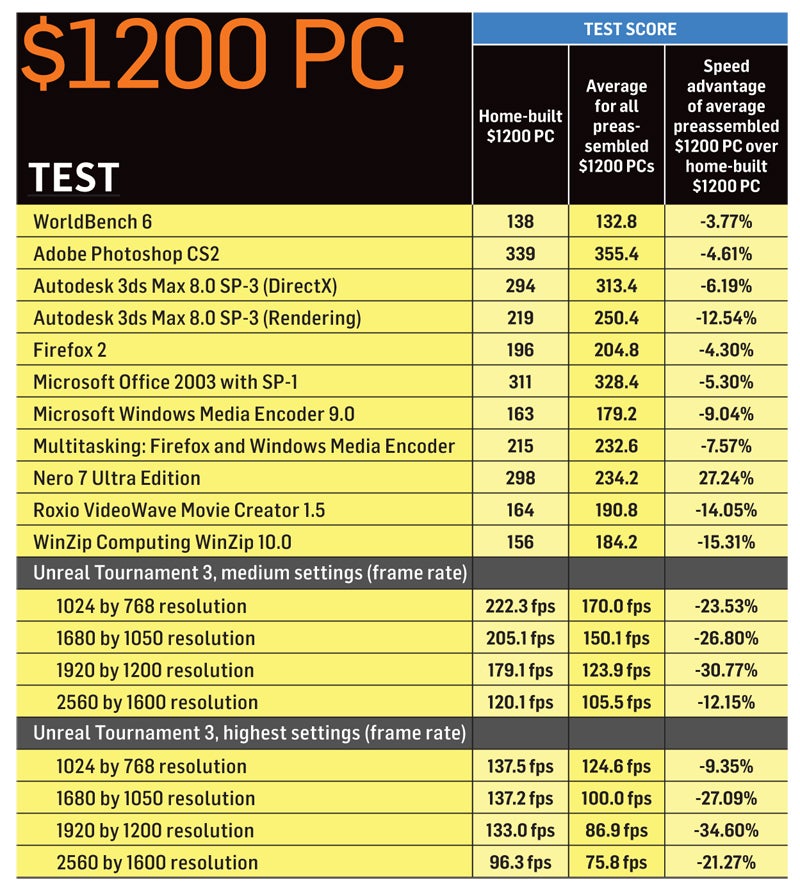
Our $1200 machine's WorldBench 6 performance was almost 4 percent better than the average for the mainstream desktop PCs category. That's a marginal bump, but bear in mind that the Core i7-875K processor we used is unlocked and thus overclocker-friendly. If you're feeling a little ad venturous, you can easily push the CPU beyond its stock clock speeds and get a little more mileage out of your system. You can ob tain even more legroom by upgrading from the inexpensive CPU cooler we selected to something a bit larger. Even if you'd rather not dabble with overclocking, you won't find it easy to beat our performance results at this price.
Graphics performance was also noteworthy, which will please builders looking to play some games on their rig. Our $1200 PC's XFX Radeon HD 5850 trumped the mainstream PC category average in our gaming tests, across the board.
As with our budget model, taking the do-it-yourself route enabled us to choose a fairly versatile case. The Zalman Z7 chassis has plenty of bays for future expansion, while muffling much of the racket that the components make.
Parts List: $500 PC
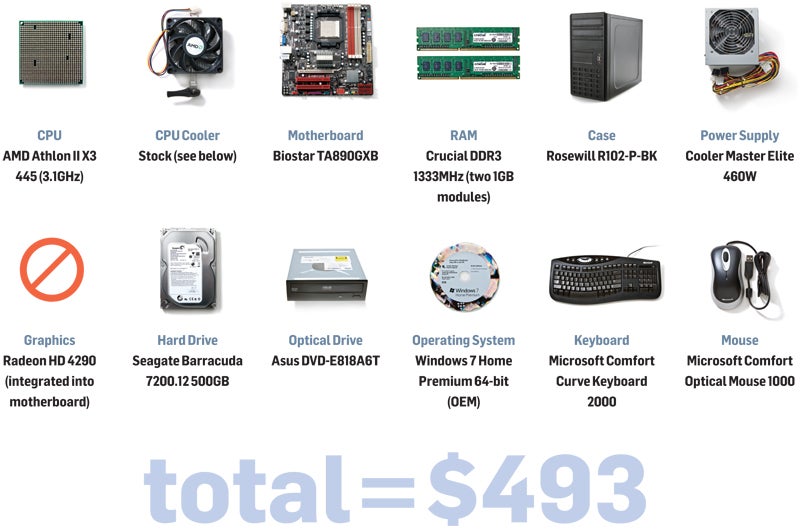
It's not easy to build a PC for just $500 in parts. No matter how you slice it, you're going to have to make some sacrifices. That said, we were impressed at how much computing power we could get for $500. Here are the parts we chose for our $500 PC build, along with the reasons we picked them. The prices listed here are ones we found at reputable online stores; the numbers may have shifted by the time you read this.
CPU
AMD Athlon II X3 445 (3.1GHz)
$90
At the low end of the price range, AMD's processors provide really good bang for the buck. What's more, choosing this CPU enables us to use an affordable motherboard with very good integrated graphics.
CPU Cooler
Stock part (see below)
$0
The AMD Athlon processor that we chose comes with a stock CPU cooling fan, so we don't have to spend any extra money to get this component.
Motherboard
Biostar TA890GXB
$95
Built on the MicroATX design, this motherboard offers AMD's latest chipset, support for the full range of AMD processors, and Radeon HD 4290 integrated graphics (one of the best integrated graphics options available).
RAM
Crucial DDR3 1333MHz (two 1GB modules)
$57
We'd prefer 4GB of RAM, but our budget won't allow it. Crucial makes reliable RAM at a fair price, and this pair of 1GB DDR3 memory sticks will get the job done.
Case
Rosewill R102-P-BK
$30
It's not the best case around, but it fits our MicroATX-based motherboard nicely, it's inexpensive, and it's not ugly. On our tight budget, that's about as much as we can hope for.
Power Supply
Cooler Master Elite 460W
$30
With the components we're using, we don't need a power supply with a lot of wattage. Instead, we need one that is inexpensive and reliable, and Cooler Master's 460W model fits the bill.
Graphics
Radeon HD 4290
(integrated into motherboard)
$0
In lieu of a graphics card, we're relying on the motherboard's integrated graphics. If you're a gamer, you'll want to invest $100 in a decent graphics card--but that would take us way over our budget.
Hard Drive
Seagate Barracuda 7200.12 500GB
$49
Hard-drive storage is amazingly inexpensive these days. This 7200-rpm drive from Seagate performs quite well, holds half a terabyte, and costs about half a C-note.
Optical Drive
Asus DVD-E818A6T
$17
This is an extremely simple and basic DVD-ROM drive. It reads DVDs and CD-ROMs, but it doesn't burn discs, nor does it play Blu-ray discs. It costs only $17, which is perfect for our tight budget.
Operating System
Windows 7 Home Premium 64-bit (OEM)
$100
Linux costs less, but we want compatibility with mainstream apps. Despite having just 2GB of RAM, we opted for the 64-bit version of Windows 7, for its slight se curity edge, and for future upgradability.
Keyboard
Microsoft Comfort Curve Keyboard 2000
$15
Shopping carefully online, we found this perfectly adequate keyboard for an astonishingly low $15. At that price, it's a steal!
Mouse
Microsoft Comfort Optical Mouse 1000
$10
It isn't our favorite mouse, but it's better than the generic low-cost mice that ship with most prefab $500 PCs. And because it's dirt cheap, it helps us keep our system's overall cost under $500.
Total = $493
Parts List: $1200 PC

$1200 gives us room to choose more powerful, more visually appealing, and less noisy PC parts, for a better overall experience. This PC should be able to handle almost anything you throw at it during the next few years, from video conversions to high-end PC games. The result: a PC that truly does it all, and does it well. Here are the parts we chose for our $1200 PC, along with our rationale for choosing each. We found the prices listed here at reputable online stores; the precise numbers may have shifted by the time you read this.
CPU
Intel Core i7 875K (2.93GHz)
$310
Priced at just over $300, this Intel Core i7 processor has four cores (eight threads) to deliver plenty of power. And since it's unlocked, it gives overclockers lots of options.
CPU Cooler
Cooler Master DP6-9EDSA-0L
$11
We opted for a fairly inexpensive CPU cooler. It's fairly quiet and does a good job of keeping the processor cool, but if you plan to overclock the CPU, you'll want something a little more substantial.
Motherboard
Asus P7P55 LX
$111
This motherboard has a fanless de sign, and its two graphics slots let you run dual ATI graphics cards. The P7P55 LX supports up to 16GB of RAM and any Core i5 or i7 processor that uses the LGA 1156 socket type.
RAM
OCZ Platinum DDR 1333MHz (two 2GB modules)
$105
4GB is enough for any modern home PC, and we'll have two slots open, so we can double our system's memory later by adding another pair of 2GB memory sticks.
Case
Zalman Z7 Plus Black ATX Tower
$67
The Z7 Plus is a great midsize tower PC case for the price. It looks nice, has thick sides to dampen noise, and includes several large (120mm) fans to keep things cool.
Power Supply
Antec EA650 650W
$80
Antec's EarthWatts power supplies are energy-efficient and reasonably priced. We don't need 650 watts for the components we've chosen, but it's smart to build in a little breathing room for future upgrades or overclocking.
Graphics
XFX Radeon HD 5850
$285
This is one of the best sub-$300 graphics cards out there. It's quiet, it supports DirectX 11, and it can run every modern game, even at high detail levels.
Hard Drive
Seagate Barracuda 7200.12 750GB
$60
This drive resembles the excellent workhorse we used in our $500 PC, only with 50 percent more storage capacity. We wanted to get the 1TB model, but we're pushing the $1200 limit as it is.
Optical Drive
Asus DRW-24B1ST
$23
This model is quite capable. It burns single and double-layer DVDs as well as CDs, so with the exception of Blu-ray support, it does everything you could want of an optical drive.
Operating System
Windows 7 Home Premium 64-bit (OEM)
$100
To make full use of our 4GB of RAM, we want the 64-bit edition of Windows 7. Even if our configuration were more modest, we'd still want 64-bit: It's the future.
Keyboard
Microsoft Comfort Curve Keyboard 2000
$15
This very serviceable keyboard has an unbeatable price. (It's the same one we chose for the $500 PC.) We couldn't find anything better that didn't cost at least $20 or $30 more.
Mouse
Logitech MX 518
$36
Our more expensive PC requires a better mouse than the $500 system's Microsoft Comfort Optical Mouse 1000. Logitech's MX 518 is large and comfortable, tracks smoothly, and is sensitive enough for gamers.
Total = $1203
Tools

To open the boxes that components arrive in, keep a box cutter or a sharp knife handy. You'll also need to cut away any cable ties that stand in the way.
Quite a few screws will accompany each of your components, and they may not be interchangeable. Keeping things organized will simplify your work. You'll need aPhillips-head screwdriver to put everything together, so be sure to have one available.
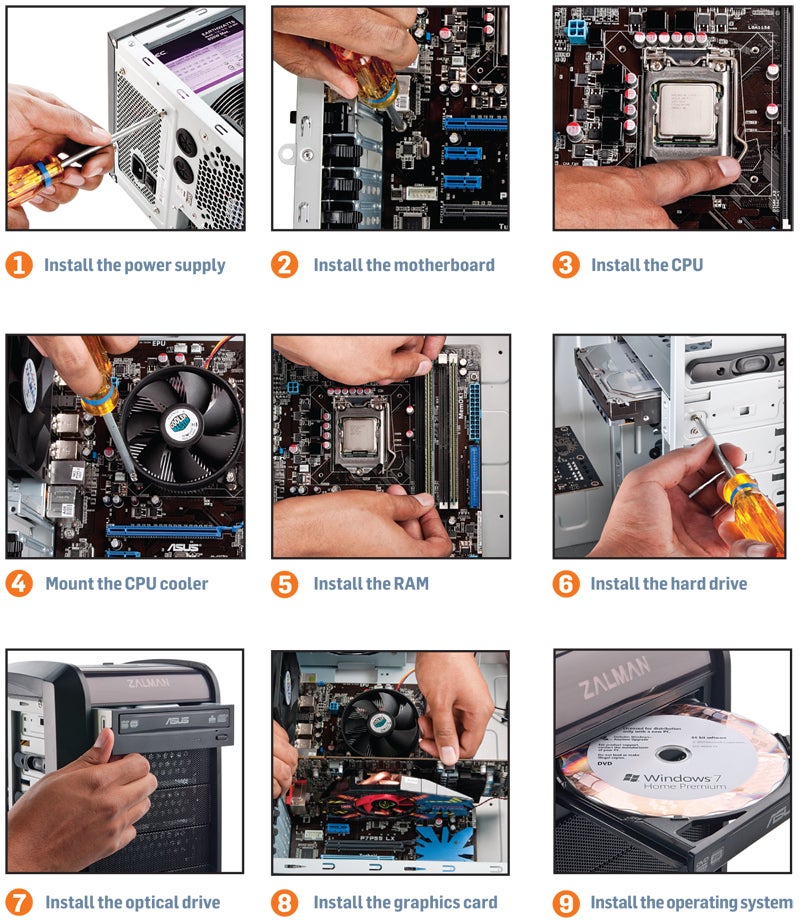
Finally, have a few twist ties and cable ties on hand. Building a PC can be messy work, with a rat's nest of wires protruding from the power supply and plugged into your components. But besides being annoying while you're mucking about inside the case, tangled wiring can cause components to get hotter than they otherwise would while your PC is running. Tying back cables to keep them out of the way will keep cool air flowing throughout the chassis.
Step by Step
Assembling a PC isn't as hard as you might think. Just clear a couple hours from your day and find a big, clean space to work in. Following are the nine steps you'll take to assemble your homemade PC. As you'll see, it's not very technical and doesn't require special tools or skills. For a more detailed demonstration of building a PC, see our video series.
How to Build Your Own PC, Part 1
How to Build Your Own PC, Part 2
How to Build Your Own PC, Part 3
1. Install the power supply: Line up the power supply's holes with the mounting space in the case, and screw it in.
2. Install the motherboard: Screw the spacers into your case, and then screw the motherboard onto the spacers. Plug the power supply and case buttons (power, reset) into the motherboard.
3. Install the CPU: Gently place the processor in the socket, and fold the lever down to lock it in place. Place thermal grease on the CPU if necessary, and then snap or screw on the CPU cooler.
4. Mount the CPU cooler: Position the CPU cooler over the mounting holes, adding a dab of thermal paste to the CPU if necessary. Some coolers have snaps and some have screws; either way, tighten it down securely.
5. Install the RAM: Line up the notch in the RAM with the slot and press firmly until it snaps into place.
6. Install the hard drive: Screw the hard drive into the mounting brackets (usually in the front of the case). Attach the SATA power cable from the power supply, and the SATA data cable to the motherboard.
7. Install the optical drive: If you have rails, screw the drive onto them and slide it into the case. If not, slide the drive in and screw it into position. Attach the SATA power cable from the power supply and the SATA data cable to the motherboard.
8. Install the graphics card: If you're using integrated graphics, you can skip this step. Push the graphics card firmly down to seat it in the large PCIe slot closest to the CPU. Then plug in the power connectors from the power supply.
9. Install the operating system: Attach your keyboard, mouse, and monitor; then turn on your PC and put the Windows disc in your optical drive. Follow the prompts to install your OS, and you're done!
Infection-Fighting Herbs
by Linda B. White, M.D.Germs are everywhere. Some take up residence in our bodies and do us good, such as the friendly bacteria that colonize the linings of the intestines, upper respiratory tract, and lower urinary system, out-competing bad microbes, contributing to immune defense and good digestion. Other microbes – viruses, bacteria, parasites – wreak havoc when they invade our bodies. Fortunately, a number of herbs have antimicrobial effects. Many of these herbs are culinary herbs and spices, such as garlic, ginger, thyme, and cinnamon. That means, no matter where you are, you can probably find an herbal ally at the local grocery store. Herbs don’t act as quickly or as potently as drugs. For serious infections, antibiotics can save lives. On the other hand, herbs produce fewer side effects and don’t seem to be associated with the microbial resistance that plagues antibiotics. |
 Garlic (Allium sativum) has broad activity against a number of organisms and also promotes immune function. People around the globe have used the bulb as food and medicine for thousands of years. Four French thieves added to garlic’s fame by staying alive as they either robbed or interred (the story varies) victims of the plague. Their alleged secret? Internal and external use of a vinegar made of garlic and other antimicrobial herbs. This ‘vinaigre des quatre voleurs’ is still sold in France. Garlic has antibacterial activity againstStaphylococcus,Streptococcus, Proteus,Pseudomonas,Mycobacterium, as well as species associated with diarrhea (Escherichia coli, Salmonella, Clostridum, Klebsiella, Bacillus subtulis). Happily, though somewhat mysteriously, garlic interferes with disease-causing bacteria, rather than the “friendly” bacteria such as Lactobacillus that colonize the intestines. Garlic also tackles fungi (Candida, Cryptococcus, Trichophytoni) and parasites such as (Giardia lamblia, Entamoeba histolytica,Trypanosomes, Leishmania). Garlic (Allium sativum) has broad activity against a number of organisms and also promotes immune function. People around the globe have used the bulb as food and medicine for thousands of years. Four French thieves added to garlic’s fame by staying alive as they either robbed or interred (the story varies) victims of the plague. Their alleged secret? Internal and external use of a vinegar made of garlic and other antimicrobial herbs. This ‘vinaigre des quatre voleurs’ is still sold in France. Garlic has antibacterial activity againstStaphylococcus,Streptococcus, Proteus,Pseudomonas,Mycobacterium, as well as species associated with diarrhea (Escherichia coli, Salmonella, Clostridum, Klebsiella, Bacillus subtulis). Happily, though somewhat mysteriously, garlic interferes with disease-causing bacteria, rather than the “friendly” bacteria such as Lactobacillus that colonize the intestines. Garlic also tackles fungi (Candida, Cryptococcus, Trichophytoni) and parasites such as (Giardia lamblia, Entamoeba histolytica,Trypanosomes, Leishmania). |
Antiviral activity includes influenza A and B, cytomegalovirus, rhinovirus, HIV, herpes simplex virus 1 and 2, rotavirus, and some species that cause pneumonia. One study found that people who took a garlic supplement for 12 weeks from November through February had far fewer colds that those who took a dummy pill. Other Allium species (chives, onions, leeks) have antimicrobial activity too. Much of the information about garlic’s antimicrobial power comes from lab studies. Less is known about how well garlic preparations work in humans infected with these “bugs.” The same can be said about most of the other herbs listed below. Heat deactivates garlic’s antimicrobial ingredients. For that reason, it’s best to consume it raw or as a tablet that promises a certain amount of allicin (a key active chemical). If you apply garlic topically as a paste, protect the skin with olive oil (or some other oil), cover with gauze or clean cloth, and remove after an hour.
Ginger (Zingiber officinale) has scientific backing as an anti-nausea agent. It may offer other benefits to those stricken with infections diarrhea. Alcohol extracts of ginger are active against bacteria that infect the intestinal tract (Salmonella typhimurium, Escherichia coli, Vibrio cholerae Pseudomonas aeruginosa, Helicobacter pylori), skin and other soft tissues (Staphylococcus aureus), and respiratory tract (Streptococcus pyogenes, Streptococcus pneumoniae, Haemophilus influenzae). Ginger has antifungal activity against the yeast Candida albicans. It also discourages intestinal worms. Because studies have shown that heat deactivates the antibacterial effect, it may be best to consume ginger raw, or in tincture or capsule form. A number of other culinary spices not only enhance flavor, but also help preserve food due to their antimicrobial effects. For instance, the two main species of cinnamon, Cinnamomum cassia (also called C. aromaticum) and Cinnamomum verum (also called C. zeylanicum), both have antibacterial and antihelminthic (anti-worm) effects. Other culinary spices and herbs that fit into this category include clove, nutmeg, chili peppers (including cayenne), horse raddish, cumin, and tamarind. Several mint family plants commonly used as culinary and medicinal herbs counter infection. Members of this family owe their characteristic tastes, smells, and medicinal effects to their essential oils, some of which are antimicrobial. Examples includethyme (Thymus vulgarus and other species), sage (Salvia officinalis), oregano (Origanum vulgare and other species),rosemary (Rosmarinus officinalis), basil (Ocimum basilicum),lavender (Lavandula species), peppermint (Mentha X piperita), and spearmint (Mentha spicata). Thyme, bee balm (Monarda fistulosa and Monarda didyma), and oregano contain the potent antimicrobial chemical thymol, which is a key ingredient in Listerine®. There are many ways you can make use of mint-family herbs. For instance, if you’ve come down with a cold or flu-like illness, you can make broth-based vegetable soup, adding thyme, rosemary, and oregano before serving. If you have cough or nasal congestion, you can boil a pot of water, add a handful of mint-family herbs (which are also decongesting and expectorant), cover and steep for 10 to 15 minutes. Remove the lid, lean over, corral the vapors with a towel, and inhale deeply. Eucalyptus, though not in the mint family, is another great herb to use in steam inhalation. Alternatively, you can add one or two drops of essential oil of peppermint essential oil just-boiled water and inhale the vapors. Thyme and oregano are too irritating to use in steam inhalation. If you have asthma, inhalation of essential-oil-laced steam may provoke bronchospasm (tightening of the airways) and is therefore not recommended. Do not take essential oils internally. If you have a sore throat, you can gargle with a tea made from mint-family plants or their essential oils. Sage tea is often recommended for this purpose. If you wish to gargle with it, add ¼ teaspoon salt to ½ cup hot (but not scalding) tea. One study found a throat spray made with echinacea (which is antiseptic, immune enhancing,and numbing) and sage worked as well as a conventional spray made from the antiseptic chlorhexidine plus the anesthetic lidocaine. An earlier study showed that a spray made from sage alone was more effective than a dummy spray. If you use essential oil, add only 1 drop to a cup of salty water in a jar and shake well before gargling. Because plant essential oils are very strong, do not drink this mixture. Simply gargle and split.
 As mentioned in the previous paragraph,echinacea has some antiviral and antibacterial properties, though its ability to help people recover faster from infections seems to stem from immune enhancement. However, a recent study found that Echinaforce®, a special extract made from Echinacea purpurea, inhibited some respiratory bacteria, including Streptococcus pyogenes, the cause of “strep throat.” Studies have yet to evaluate the use of this product in treating “strep throat.” Because such infection can cause signification illness and complications such as rheumatic heart disease, antibiotics are recommended. That said, a number of studies have shown that good product, taken frequently in adequate amounts can shorten the course of viral respiratory infection. As mentioned in the previous paragraph,echinacea has some antiviral and antibacterial properties, though its ability to help people recover faster from infections seems to stem from immune enhancement. However, a recent study found that Echinaforce®, a special extract made from Echinacea purpurea, inhibited some respiratory bacteria, including Streptococcus pyogenes, the cause of “strep throat.” Studies have yet to evaluate the use of this product in treating “strep throat.” Because such infection can cause signification illness and complications such as rheumatic heart disease, antibiotics are recommended. That said, a number of studies have shown that good product, taken frequently in adequate amounts can shorten the course of viral respiratory infection. |
Black elderberry (Sambucas nigra) and licorice (Glycyrrhiza glabra) are two other herbs to keep handy during the cold and flu season. Elderberry has antiviral activity against influenza viruses and enhances immune function. A proprietary elderberry extract (Sambucol®) significantly shortens the severity and duration of influenza. Licorice root is demulcent (soothing), expectorant (expels respiratory mucus), antiviral, and immune enhancing. Because it acts on the kidneys to stimulate retention of sodium and water (and loss of potassium), it can’t be taken for more than a few days running. It should not be taken by pregnant women, nor people with heart disease, kidney disease, or high blood pressure.
Berberine is an antimicrobial plant chemical present in herbs such as goldenseal (Hydrastis Canadensis), Oregon grape (Berberis aquifolium), barberry (Berberis vulgaris), and coptis or goldenthread (Coptis chinensis). The bad news is that this chemical isn’t well absorbed from the intestinal tract. In other words, if you have a sinus infection, taking goldenseal or Oregon grape root by mouth likely won’t deliver much berberine to your sinuses. The good news is that berberine does a good job of treating intestinal infections. Studies show that it inhibits bacterial diarrhea caused by Vibrio cholera and Escherichia coli. Berberine is also antiparasitic against Giardia lamblia, Entamoeba histolytica(amoebas), Trichomonas vaginalis, and Leishmania donovani. Studies also show that berberine helps clear giardia in humans. It’s also reasonable to apply root preparations topically to infected areas. For instance, a well-strained decoction (with ¼ teaspoon salt added for each cup) could be used as a nasal douche for sinusitis, a vaginal douche, or an eyewash for mild pinkeye. Studies have demonstrated success in treating a serious eye infection caused by Chlamydia trachomatis. Nevertheless, you should see your doctor if the whites of one or both your eyes look inflamed, especially in the presence of a yellow-green discharge. Cranberry (Vaccinium macrocarpon), taken as a juice or concentrated in tablet form, interferes with bacterial adherence to bladder lining, thus preventing infection. Most of the research has been in women (elderly women, young sexually-active women, and pregnant women) prone to repeat bladder infections. Once infection begins, the bacteria have already attached to the bladder lining. At that point, antibiotics can clear the infection swiftly and prevent bacteria from ascending to the kidneys. For prevention, the juice dosage used in studies ranges from 4 to 32 ounces a day. Alternatively, concentrated juice extract can be taken at a dosage of one 300-400 milligram tablet, two to three times a day. Side effects can include gastrointestinal upset. Also, chemical constituents of cranberry may inhibit the enzymes that break down drugs, thereby raising blood levels of medications such as Coumadin, Valium, Elavil, Motrin, and others.
 Pink New Zealand Tea Tree |
Posted via email from WellCare
Schotzis Bar Open Mic Contest in Austin, Tx
Schotzis Bar Open Mic Night w/ dollar wells @ Schotzi's! Come out @ 9pm to play some 42. Don't forget, for all the local talent Schotzi's will be starting an open mic contest in the coming weeks with prizes every Monday and grand prizes including cash, free demo, and more.
Why Intel Is Buying Infineon
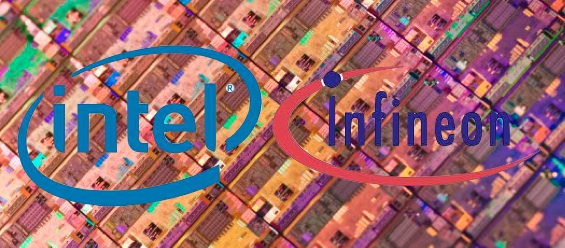
Intel is about to fork over $1.4 billion for the wireless products division of Infineon--partly to screw Apple (which has been busy ignoring Intel in its iPhones and iPads), partly to cosy-up to its old mate Microsoft.
It's a $1.4 billion deal due for completion in early 2011 (because there's likely to be a lot of regulatory concern about the deal and Intel's monopolistic past). Intel is acquiring only part of Infineon, its Wireless Solutions Business (dubbed WLS) and has been quick to stress--probably to appease the FTC even at this early stage--that WLS will continue to operate as a stand-alone business, and "Intel is committed to serving WLS' existing customers, including support for ARM-based platforms."
The two companies also try to illustrate that the deal is all about "Intel's computing strategy," aligning with the "Internet connectivity pillar" of the business, along with improving "Wi-Fi and 4G WiMAX offerings" by leveraging "Infineon's 3G capabilities" and that it all "supports Intel's plans to accelerate LTE."
But the real reasoning behind the deal is all about Intel's complicated relationship with Apple and Microsoft--it's coded into this bit from the press release: "The acquired technology will be used in Intel Core processor-based laptops, and myriad of Intel Atom processor-based devices, including smartphones, netbooks, tablets and embedded computers."
Apple and Intel partnered up several years back when the computer maker made a huge switch away from its IBM PowerPC CPU architecture. Since then, the two have been close collaborators for chips inside Apple's Mac-based computers--even seeing a one-off special-edition low profile chip being designed by Intel for the first-generation MacBook Air. But the fastest growing portion of Apple's business has been the iPod, iPhone, and iPad mobile-devices sector, and these devices (which have overturned three different markets) don't use Intel chips: The iPad in particular is a challenge to Intel's dominance of the portable PC market, and it even uses Apple's own-branded ARM-architecture A4 CPU, and has been selling like hot cakes. With Apple's moves into this market, Intel's execs must've been getting antsy, and back in July there was even some thinking that Apple could buy Infineonand really ratchet-up its vertical integration to challenge Intel directly. Intel and Apple's relationship is complicated. And now its got more so.
Meanwhile Intel's long term "best friend" Microsoft has been seeing its dominance over the high-tech world take bigger and bigger hits: Its smartphone business has all but fallen into the toilet bowl, and the netbook phenomenon succeeded based on an old (and increasingly aged-looking and PR-damaging) Microsoft product--XP. And now the netbook phenomenon looks like its being overtaken by the tablet PC revolution, led by Apple and a horde of Android clones. Microsoft's big hope to grab some of the limelight back are its Windows Phone 7 series devices, and tablet-friendly Windows 7 OS. If Intel can get itself into Microsoft's good books, and offer powerful battery-friendly CPUs and lots of the base-band electronics for smartphones that are specifically tailored to MS requirements, then maybe its Intel's in-route to the mobile device market.
What's the next development in this story going to be? It may be an odd one: Apple may choose to spend some of its gigantic war chest of cash reserves on buying a competing business to Infineon.
WW III Timeline
These, some believe, will be the stages of the planned Third World War:
- Prelude - The events leading up to the start of World War Three, including Sept 11, 2001.
- Act 1 - The Middle East. Widespread conflict to bring the entire region into the flames of war, possibly triggered by Iran or militants in Pakistan using North Korean supplied nuclear arms. The first Scene in this Act is the US Invasion of Iraq on March 20, 2003.
- Act 2 - Israel at War -- Against her Arab neighbors, possibly Palestine. A Palestinian State will be established, so that all Israelis will be fully separated from Palestinians (listen out for mention of a 7-year treaty to be confirmed by a World Leader - probably Bush), only for Israel to viciously attack Palestine shortly thereafter.
- Act 3 - Far East -- "Hair-raising nuclear confrontation that threatens mankind's existence" - Peter Lemesurier, author of The Armageddon Script, p. 223, written in 1981. Includes China invading Taiwan and a nuclear eruption on the Korean Peninsula.
- Act 4 - Erosion of Confidence in 'The System' so severe citizens will be panicked into giving up liberties and Constitutional form of government. The plan calls for the dissolution of the US Constitution, triggered by a significant enough 'terrorist' attack. The ultimate intent is to introduce a global government and one-world religion.
Act 5 - The collapse of the US, and other Western economies and morals.
- Act 6 - Significant population reduction using natural and man-made disasters.
- Curtain. Who can tell how this war will end?
Both Biblical prophecy and the Illuminati plan state that Israel is the key. The Third World War is planned to begin when Israel goes to war against her Arab enemies. Then, and only then, will all the other elements begin to occur and they will do so in rapid succession. The plan is to have one disaster following another in such rapid succession that, before people can mentally and emotionally handle one disastrous news event, they will be hit with another. It is also accurate to say that until ALL of the elements for WW3 are in place, the plan will not commence.
While it would be naive to suggest a specific timeline for the events leading up to and including World War 3, we do know that the plans for World War 3 are well advanced, and our leaders involved in this secret plan are waiting only for the right signal before all-out war begins.
We are in the last stages of the preparation to so globalize the world that the Masonic New Age Christ (Antichrist) can appear to receive all the political and economic power of the world's rulers. This is the Illuminati plan and Biblical prophecy (Revelation 17:12-17).
In the words of Peter Lemesurier, author of The Armageddon Script:
"Their script is now written, subject only to last-minute editing and stage-directions. The stage itself, albeit in darkness, is almost ready. Down in the pit, the subterranean orchestra is already tuning up. The last-minute, walk-on parts are even now being filled. Most of the main actors, one suspects, have already taken up their roles. Soon it will be time for them to come on stage, ready for the curtain to rise. The time for action will have come."
The New World Order (NWO) An Overview
By Ken Adachi
There is a worldwide conspiracy being orchestrated by an extremely powerful and influential group of genetically-related individuals (at least at the highest echelons) which include many of the world's wealthiest people, top political leaders, and corporate elite, as well as members of the so-calledBlack Nobility of Europe (dominated by the British Crown) whose goal is to create a One World (fascist) Government, stripped of nationalistic and regional boundaries, that is obedient to their agenda. Their intention is to effect complete and total control over every human being on the planet and to dramatically reduce the world's population by 5.5 Billion people. While the name New World Order is a term frequently used today when referring to this group, it's more useful to identify the principal organizations, institutions, and individuals who make up this vast interlocking spiderweb of elite conspirators.
The Illuminati is the oldest term commonly used to refer to the 13 bloodline families (and their offshoots) that make up a major portion of this controlling elite. Most members of the Illuminati are also members in the highest ranks of numerous secretive and occult societies which in many cases extend straight back into the ancient world. The upper levels of the tightly compartmentalized (need-to-know-basis) Illuminati structural pyramid include planning committees and organizations that the public has little or no knowledge of. The upper levels of the Illuminati pyramid include secretive committees with names such as: the Council of 3, the Council of 5, the Council of 7, the Council of 9, the Council of 13, the Council of 33, the Grand Druid Council, the Committee of 300 (also called the "Olympians") and the Committee of 500 among others.
In 1992, Dr John Coleman published Conspirators' Hierarchy: The Story of the Committee of 300. With laudable scholarship and meticulous research, Dr Coleman identifies the players and carefully details the Illuminati agenda of worldwide domination and control. On page 161 of theConspirators Hierarchy, Dr Coleman accurately summarizes the intent and purpose of the Committee of 300 as follows:
"A One World Government and one-unit monetary system, under permanent non-elected hereditary oligarchists who self-select from among their numbers in the form of a feudal system as it was in the Middle Ages. In this One World entity, population will be limited by restrictions on the number of children per family, diseases, wars, famines, until 1 billion people who are useful to the ruling class, in areas which will be strictly and clearly defined, remain as the total world population.
There will be no middle class, only rulers and the servants. All laws will be uniform under a legal system of world courts practicing the same unified code of laws, backed up by a One World Government police force and a One World unified military to enforce laws in all former countries where no national boundaries shall exist. The system will be on the basis of a welfare state; those who are obedient and subservient to the One World Government will be rewarded with the means to live; those who are rebellious will simple be starved to death or be declared outlaws, thus a target for anyone who wishes to kill them. Privately owned firearms or weapons of any kind will be prohibited."The sheer magnitude and complex web of deceit surrounding the individuals and organizations involved in this conspiracy is mind boggling, even for the most astute among us. Most people react with disbelief and skepticism towards the topic, unaware that they have been conditioned (brainwashed) to react with skepticism by institutional and media influences that were created by the Mother of All mind control organizations: The Tavistock Institute of Human Relations in London. Author and de-programmer Fritz Springmeier (The Top 13 Illuminati Bloodlines ) says that most people have built in "slides" that short circuit the mind's critical examination process when it comes to certain sensitive topics. "Slides", Springmeier reports, is a CIA term for aconditioned type of response which dead ends a person's thinking and terminates debate or examination of the topic at hand. For example, the mention of the word "conspiracy" often solicits a slide response with many people. (Springmeier has co-authored three books on trauma-based programming which detail how the Illuminati employs highly tuned and extrememly sophisticated Mind Control (MC) training programs that begin the programming process while the intended victim is still within the womb. Mind Control is a much greater problem than most people realize. According to Cisco Wheeler, a former Illuminati mind control programmer, there are 10 million people who have been programmed as mind controlled slaves using trauma-based MC programs with names like Monarch and MK Ultra. The newer, non-trauma, electronic means of MC programming that grew out of the Montauk Project, may include millions more. Al Bielek, who played a principle role in the development of the Montauk Project, said that there likely 10 million victims of Montauk style mind control programming worldwide, the majority located in the USA. He also said that there are covert Montauk Programming 'Centers' in every major city in the U.S. )
What most Americans believe to be "Public Opinion" is in reality carefully crafted and scripted propaganda designed to elicit a desired behavioral response from the public. Public opinion polls are really taken with the intent of gauging the public's acceptance of the Illuminati's planned programs. A strong showing in the polls tells the Illuminati that the programing is "taking", while a poor showing tells the NWO manipulators that they have to recast or "tweak" the programming until the desired response is achieved. While the thrust and content of the propaganda is decided at Tavistock, implementation of the propaganda is executed in the United States by well over 200 'think tanks' such as the Rand Corporation and the Brookings Institute which are overseen and directed by the top NWO mind control organization in the United States, the Stanford Research Institute (SRI) in Menlo Park, California.
The NWO global conspirators manifest their agenda through the skillful manipulation of human emotions, especially fear. In the past centuries, they have repeatedly utilized a contrivance that NWO researcher and author David Icke has characterized in his latest book, The Biggest Secret, as Problem,Reaction, and Solution.
The technique is as follows: Illuminati strategists create the Problem- by funding , assembling, and training an "opposition" group to stimulate turmoil in an established political power (sovereign country, region, continent, etc.) that they wish to impinge upon and thus create opposing factions in a conflict that the Illuminati themselves maneuvered into existence. In recent decades, so called "opposition" groups are usually identified in the media as 'freedom fighters' or 'liberators' (recently the KLA-Kosovo Liberation Army).
At the same time, the leader of the established political power where the conflict is being orchestrated is demonized and, on cue, referred to as 'another Hitler' (take your pick: Saddam Hussein, Milosevic, Kadaffi, etc.). The 'freedom fighters' are not infrequently assembled from a local criminal element (i.e. KLA, drug traffickers). In the spirit of true Machiavellian deceit, the same NWO strategists are equally involved in covertly arming and advising the leader of the established power as well (the Illuminati always profits from any armed conflict by loaning money, arming, and supplying all parties involved in a war).
The conflict is drawn to the world stage by the controlled media outlets with a barrage of photos and video tape reports of horrific and bloody atrocities suffered by innocent civilians. The cry goes up "Something has to be done!" And That is the desired Reaction (note: the same technique is presently being used to bring about gun control in the United States).
The NWO puppeteers then provide the Solution by sending in UN 'Peace Keepers' (Bosnia) or a UN 'Coalition Force' (Gulf War) or NATO Bombers and then ground troops (Kosovo). Once installed, the 'peace keepers' never leave (Bosnia, Kosovo). The idea is to have NWO controlled ground troops in all major countries or strategic areas where significant resistance to the New World Order takeover is likely to be encountered.
East Timor, Indosnesia. (9/14/99) Virtually , the same strategy used to occupy Kosovo with UN/NATO troops was applied by the NWO manipulators to take military control of East Timor. Once again, the same morality play is trotted out for public consumption: the local evil and demonic Indonesian Army trained militias responsible for the slaughter of innocent civilians following the August 30 vote for Independence (from Indonesian control), must be stopped at all costs. This time, Australia (to keep up the appearance of an 'international' humantarian effort) will lead the charge with 'peacekeeping' troops. Of course, it didn't take long for Madeline Albright to announce that US 'support assets' will be part of the "UN Peacekeeping Team". In a front page story in the LA Times (9/13/99), Mike Jendrzejczyk of Human Rights Watch (an Illuminati front group) in Washington DC said that it's "crucial" that "peacekeepers have the authority to disarm militia forces and any Indonesian soldiers actively working with them". ]
The local, sovereign military force is either defeated (i.e. Yugoslavia) or, as in the case of the United States itself, replaced by foreign UN "Partnership For Peace" (PFP) troops who take over the jobs of US soldiers who have been sent overseas on 'peacekeeping' missions. In addition to being killed in ground conflicts on foreign soil, US military forces will likely be reduced in the next few years through disease induced attrition (i.e. from mandatoryAnthrax Vaccinations required of all US military personnel). These vaccinations will, in all probability, eventually produce the symptoms of the so-calledGulf War Illness, which was acquired by a certain percentage of Gulf War soldiers who were given a "special" anthrax vaccine (intended by the Illuminati/CIA as a test run to ascertain how quickly (and fatally) the disease would progress with a substantial population of healthy young men and women).
The corporate portion of the NWO pyramid seems to be dominated by international bankers and the big pharmaceutical cartels, as well as other major multinational corporations. The Royal Family of England, namely Queen Elizabeth II and the House of Windsor, (who are, in fact, descendants of the German arm of European Royalty -the Saxe-Coburg-Gotha family-changed the name to Windsor in 1914 ), are high level players, along with the British oligarchy which controls the upper strata of the Illuminati. The decision making Illuminati nerve centers of this effort are in theLondon (especially the City of London), Basel Switzerland, and Brussels (NATO headquarters).
The United Nations, along with all the agencies working under the UN umbrella, such as the World Health Organization (WHO), are full time players in this scheme. Similarly, NATO is a military tool of the NWO.
The leaders of all major industrial countries like the United States, England, Germany, Italy, Australia, New Zealand, etc. (E.g. members of the "G7/G8" ) are active and fully cooperative participants in this conspiracy. In this century, the degree of control exerted by the Illuminati has advanced to the point that only certain hand-picked individuals, who are groomed and selected by the Illuminati are even eligible to become the prime minister or president of countries like England, Germany, or The United States. It didn't matter whether Bill Clinton or Bob Dole won the Presidency in 1996, the results would have been the same (except maybe for Zipper Gate ). Both men are playing on the same team for the same ball club. Anyone who isn't a team player is taken out: i.e.President Kennedy, Ali Bhutto (Pakistan) and Aldo Moro (Italy). More recently, Admiral Borda and William Colby were also killed because they were either unwilling to go along with the conspiracy to destroy America, weren't cooperating in some capacity, or were attempting to expose/ thwart the Takeover agenda.
Most of the major wars, political upheavals, and economic depression/recessions of the past 100 years (and earlier) were carefully planned and instigated by the machinations of these elites. They include The Spanish-American War (1898), World War I and World War II; TheGreat Depression; the Bolshevik Revolution of 1917; the Rise of Nazi Germany; the Korean War; the Vietnam War; the 1989-91"fall" of Soviet Communism, the 1991 Gulf War; and the recent War in Kosovo. Even the French Revolution was an orchestrated into existence by the Barvaian Illuminati and the House of Rothchild.
FEMA
In America, the Federal Emergency Management Administration (FEMA) was created in 1979 under Presidential Memorandum 32 authored for President Carter by Prof. Samuel P. Huntington, a Harvard professor and former FEMA Advisory Board chairman. Huntington wrote the Seminal Peace for the Trilateral Commission in the mid 70's, in which he criticized democracy and economic development as outdated ideas. As co-author of another report prepared for the Trilateral Commissiosn, The Crisis of Democracy, Huntington wrote:
"We have come to recognize that there are potential desirable limits to economic growth. There are also potentially desirable limits to the indefinite extension of political democracy. A government which lacks authority will have little ability short of cataclysmic crisis to impose on its people the sacrifices which may be necessary."
Huntington's ideas were rewritten into National Security Decision Directive #47(NSDD47), which was enacted in July 1982 by President Reagan. Treated as a passing footnote by the media, this law identified legitimate areas to be upgraded to maintain national defense, but it also laid the groundwork for Emergency Mobilization Preparedness, a planunder which existing socio/economic regulations or other legal constraints would be waived in the event of a national emergency. This plan was further strengthened in Public Law 101-647, signed by President Bush in November 1990.What it boils down to is this: in the event that the President declares a national emergency, for any reason (from major earthquakes to increased international tensions or economic /financial crisis of any stripe), FEMA can then, attheir discretion, implement Executive Orders 10995 through 11005. These Executive Orders permit a takeover by FEMA of local, state, and national governments and the suspension of constitutional guarantees. FEMA will have the authority to exert any sort of control that it deems necessary upon the American public. A trained National Police Force, formally referred to by the name of Multi Jurisdictional Task Force (MJTF), wearing black uniforms and composed of:
1. specially selected US military personnel
2. foreign military units carrying United Nations ID cards, and
3. specially trained existing police groups from larger metropolitan American cities.These members of the MJTF will implement and enforce martial law under the direction and controlof FEMA. The President and Congress are out of the loop.
FEMA is the Trojan Horse by which the New World Order will implement overt, police-state control over the American populace.
War on Drugs
The "War on Drugs" is a cruel joke. The US government, specifically the CIA, is the biggest 'drug lord' on the planet. Drug money is used to pay for innumerable 'black projects', including the construction of huge underground cities housing both humans and aliens working with the secret US government.The instigation of a trumped-up war as a cover for amassing fortunes can be dated back to at least the 12th Century when only a core group of ninemembers of an Illuminati group called the Knights Templar, the military arm of an Illuminati secret society known as the Priory of Sion, kicked off theThe Crusades that lasted for over a century and a half. A rift later developed between the Templars and the Priory of Sion when Jerusalem was lost to Saracen Turks in 1187. In 1307, the king of France, Philippe the Fair (a Merovingian Illuminati), coveted the wealth and was jealous of the Templars' power. The French king, being a puppet of the Priory of Sion, set out to arrest all the Templars in France on October 13. While many Templars were seized and tortured, including their Grand Master, Jacques de Molay, many other Templars (who had been tipped off) escaped. They eventually resurfaced in Portugal, in Malta (as the Knights of Malta) and later in Scotland as The Scottish Rites of Free Masonry.
The acquisition and consolidation of ever greater wealth, natural resources, total political power, and control over others are the motivating forces which drives the decisions of the Illuminati. The toll in human suffering and the loss of innocent lives are non issues for these individuals, who are aligned with very dark and malevolent 4th dimensional aliens. The dominant group of 4th dimentional malevolent aliens controlling and manipulating the human Iluminati are known as Draconians or Drakos Reptilians. Not all alien reptilians are of a negative spiritual orientation.
Mind Control
Recent revelations from deprogrammed Illuminati (government) mind controlled individuals such as Arizona Wilder (The Biggest Secret), Cisco Wheeler( The Illuminati Formula to Create an Undetectable Total Mind Control Slave), Cathy O'Brien (Trance Formation of America), and Brice Taylor (Thanks for the Memories) leave NO DOUBT that the upper levels of the Illuminati engage in Satanic rituals which usually include the killing of young children, the drinking of human blood and the consuming of flesh and human organs.The details of the Illuminati conspiracy are brilliantly laid out in the books of David Icke (Tales from the Time Loop, Children of the Matrix, Alice in Wonderland and the World Trace Center Disaster, The Biggest Secret, The Truth Shall Set You Free, and I am Me, I am Free; and in three books by Dr. John Coleman (Conspirators' Hierarchy: The Story of The Committee of 300; One World Order: Socialist Dictatorship; and Diplomacy by Deception




